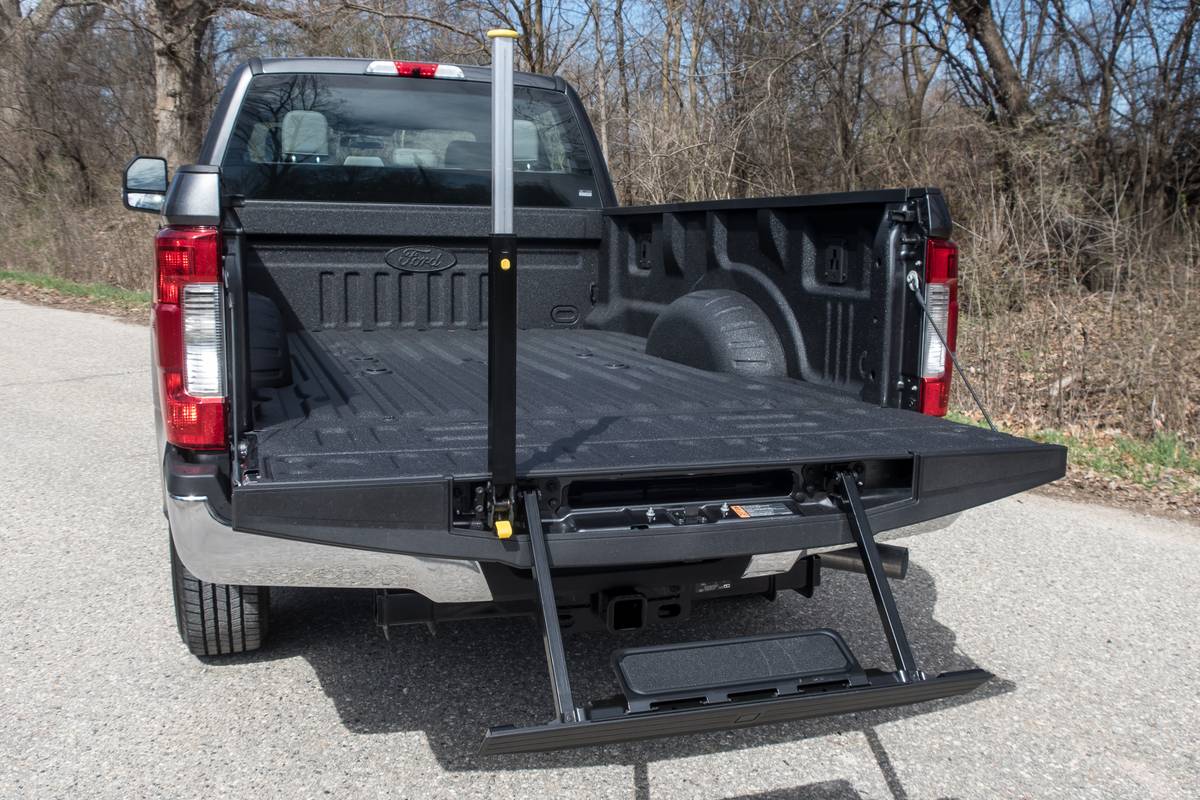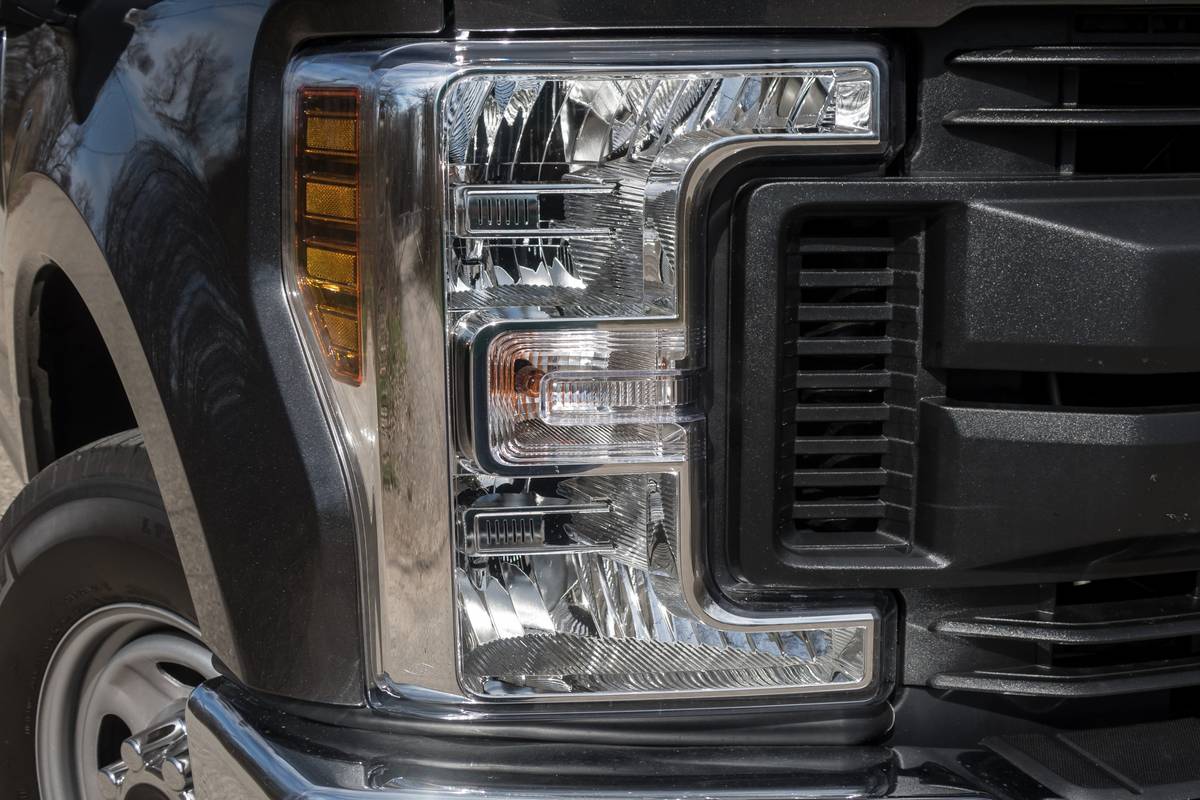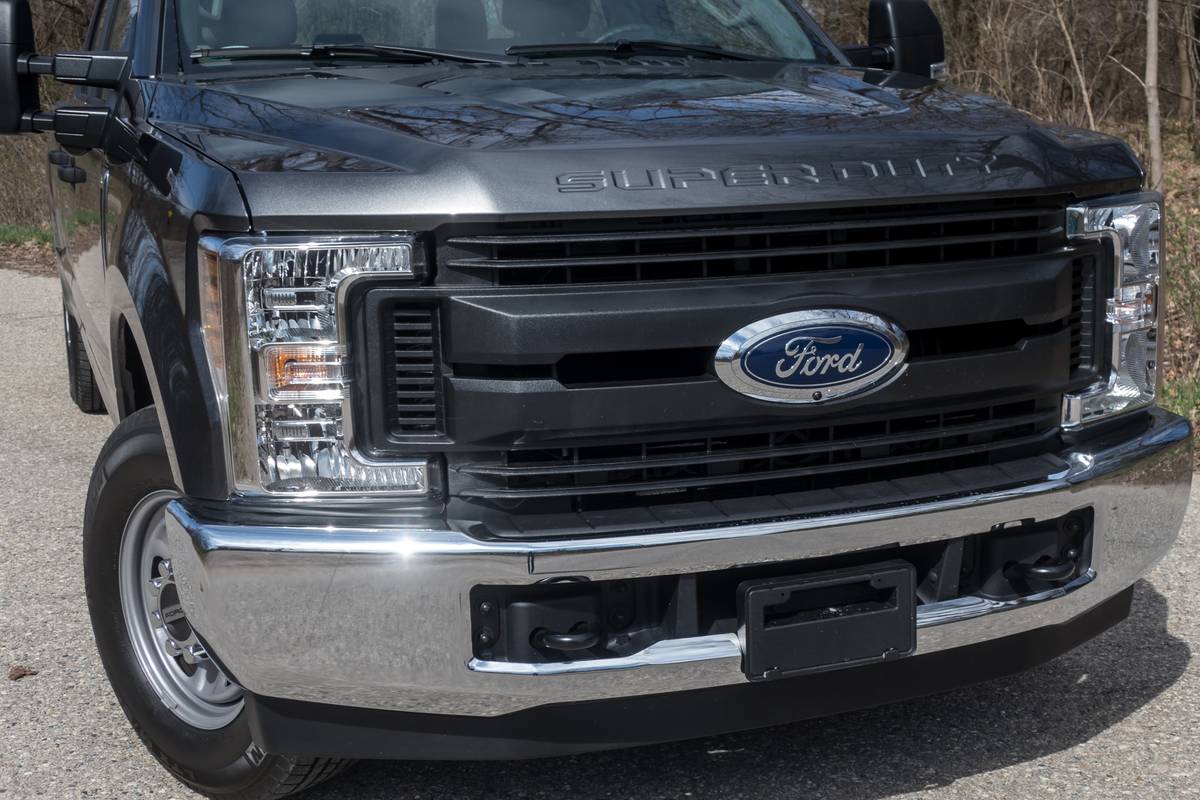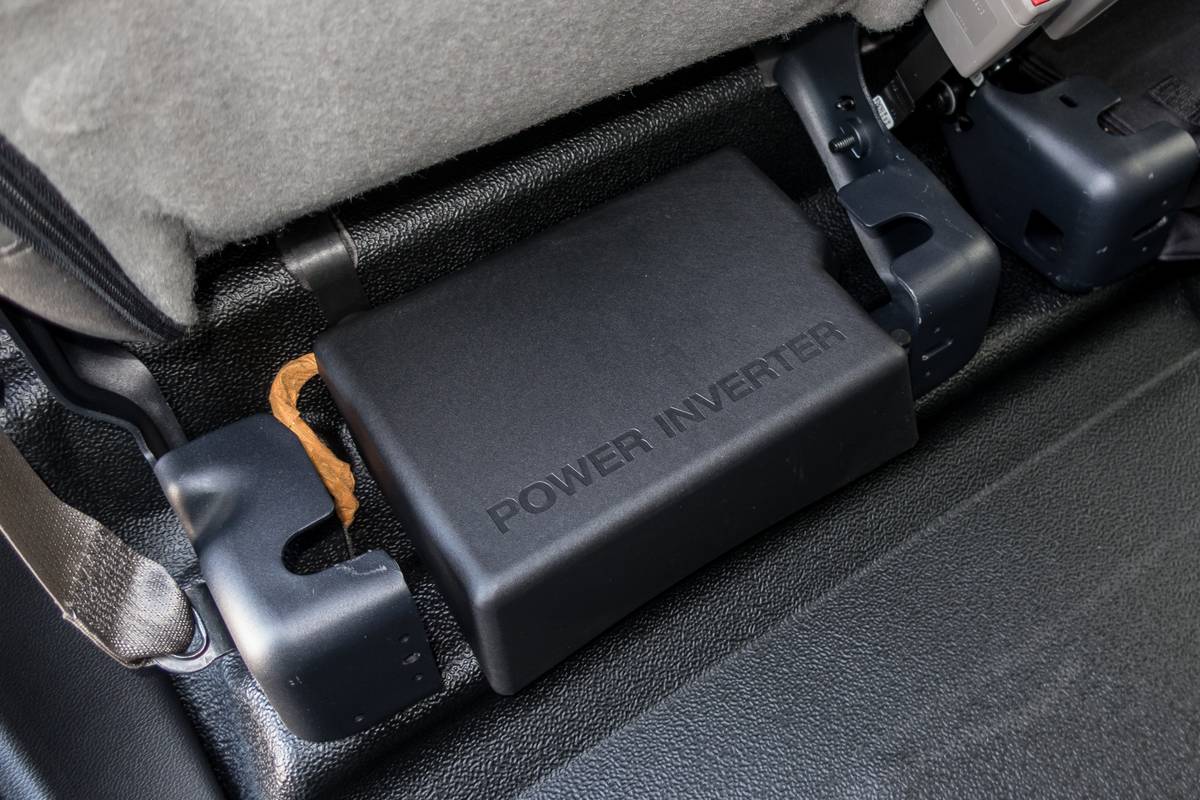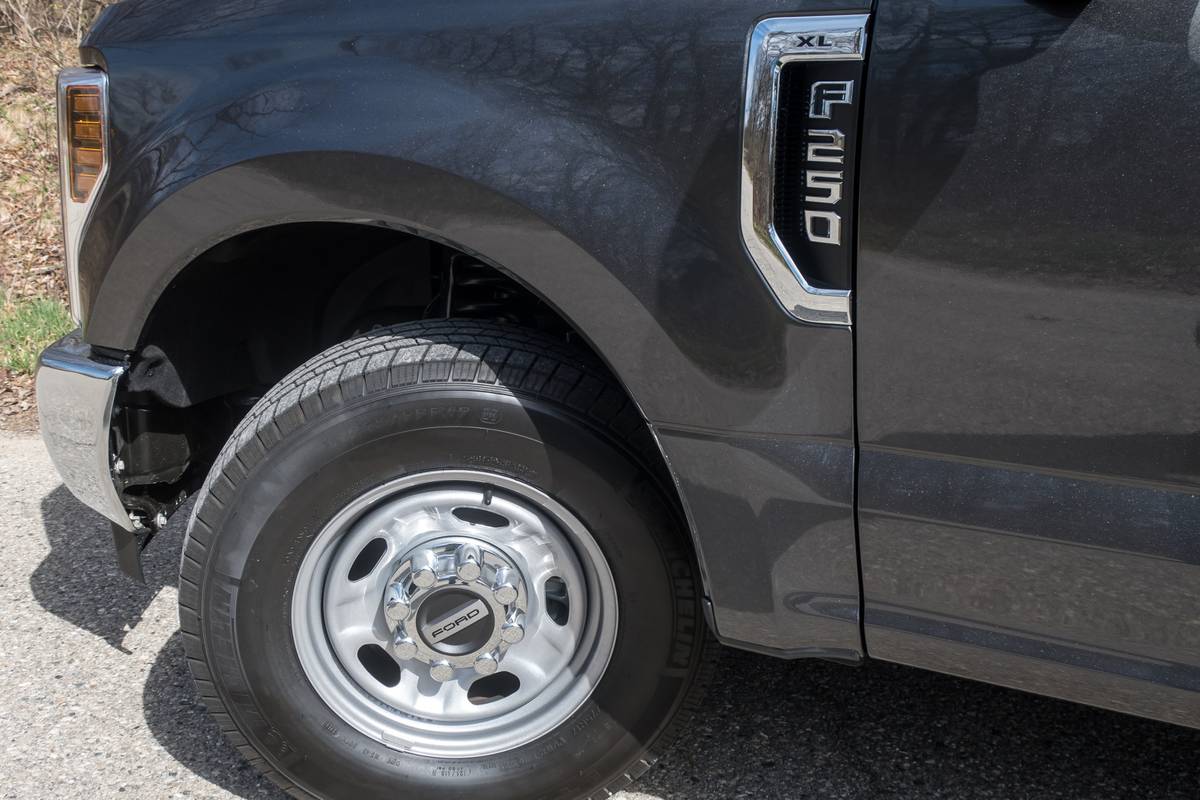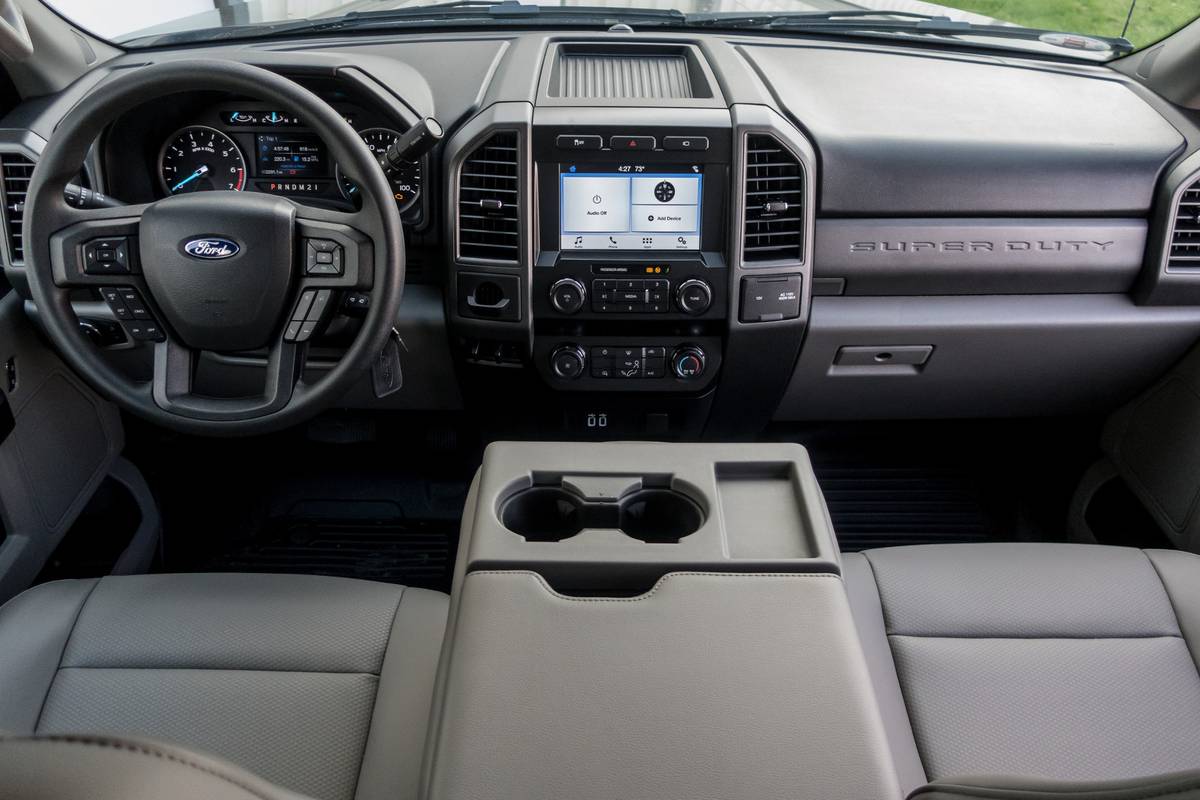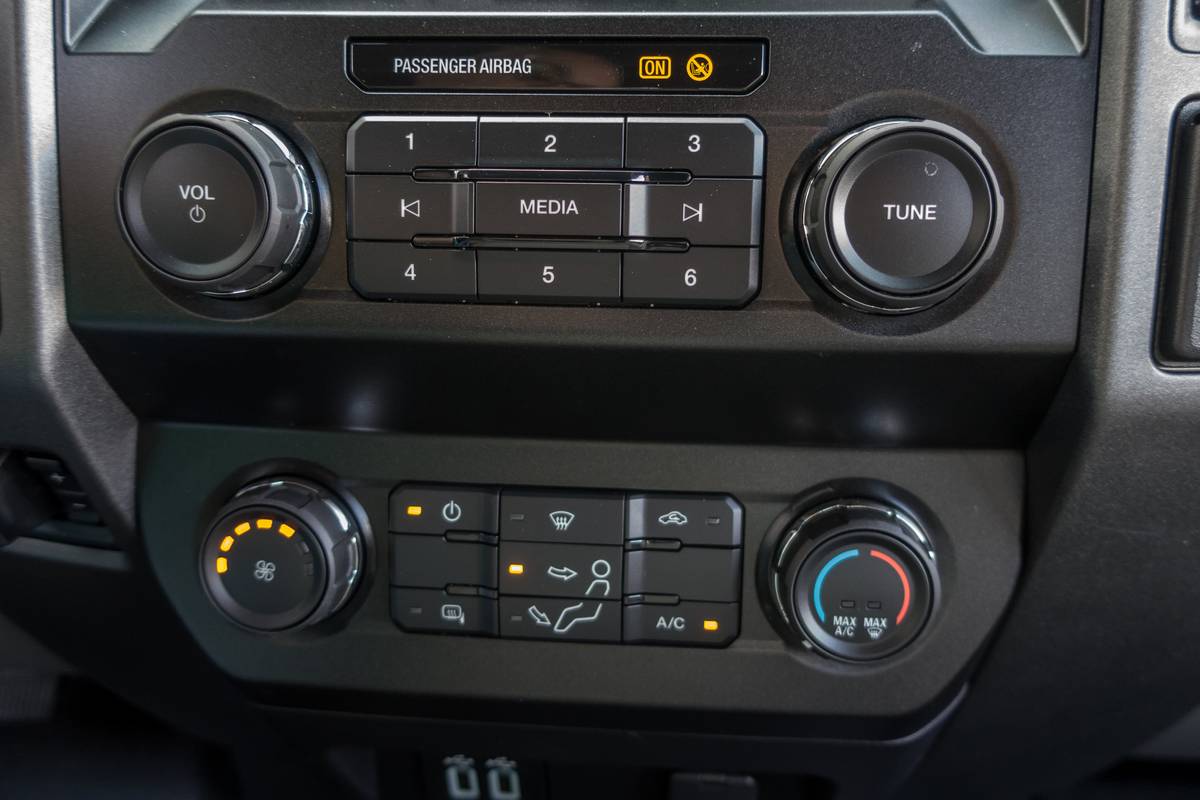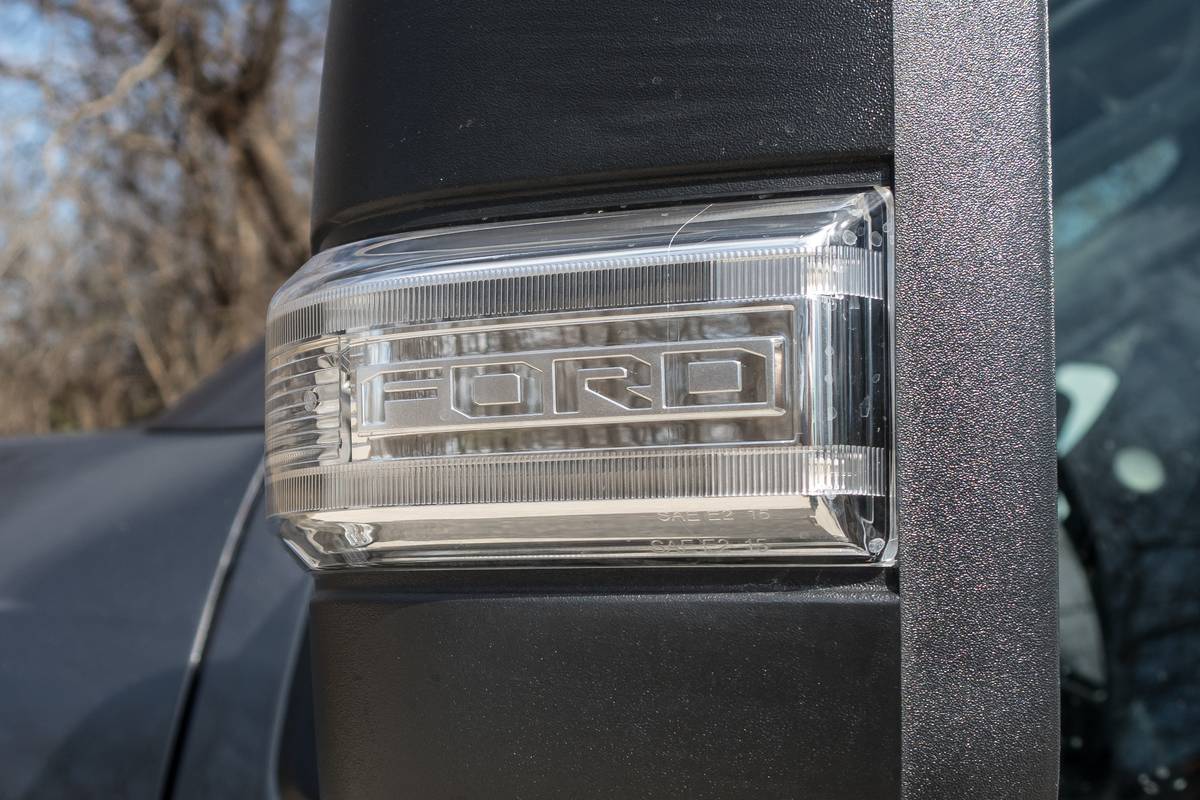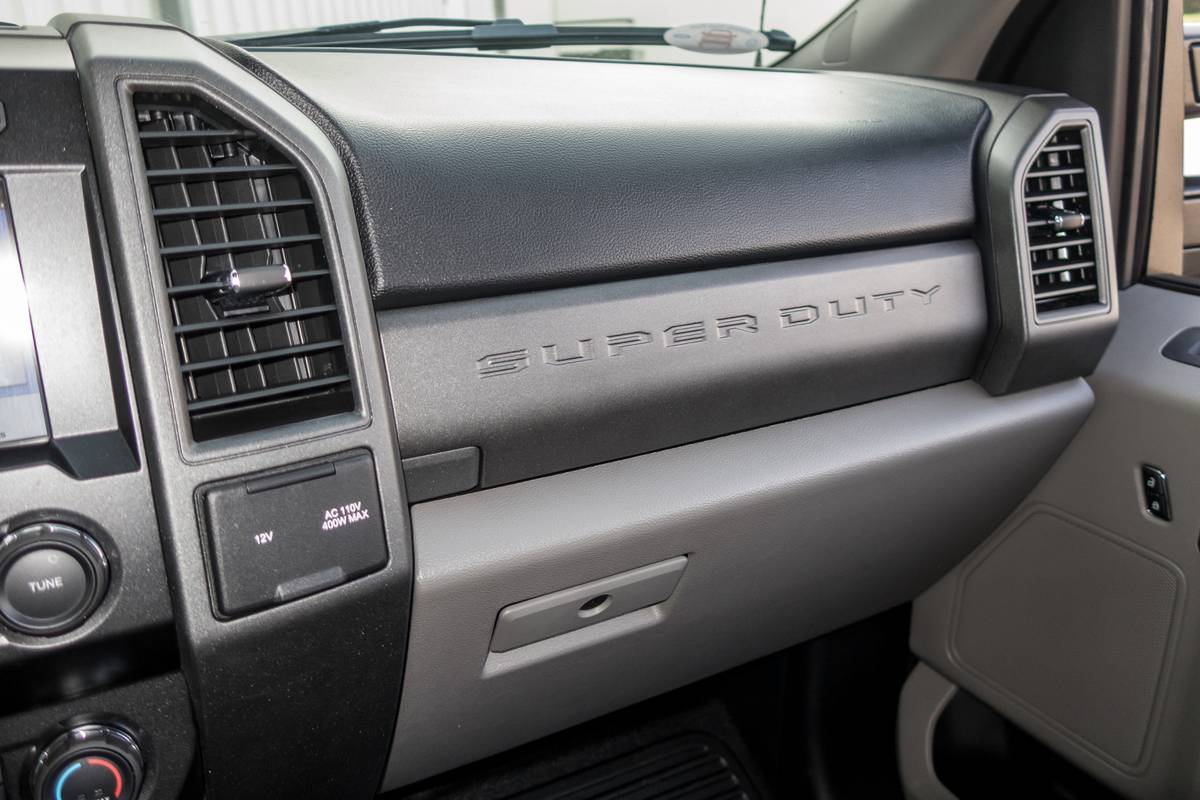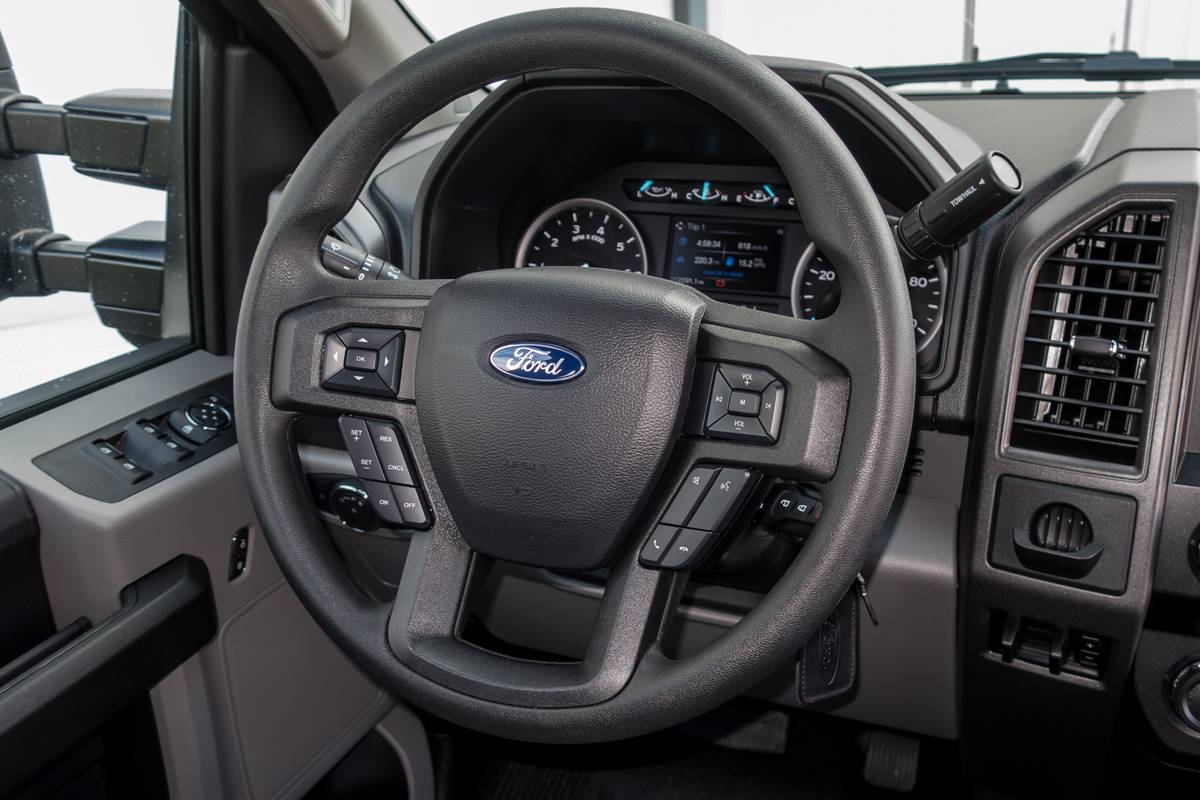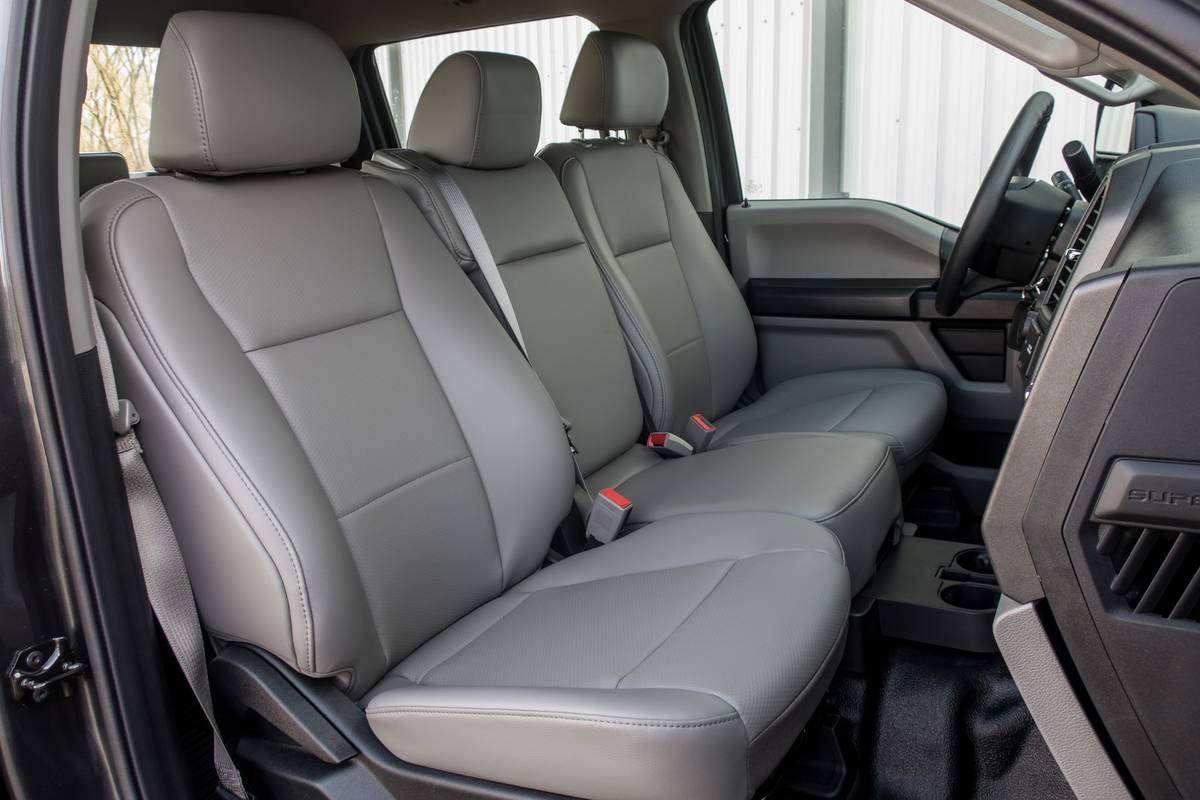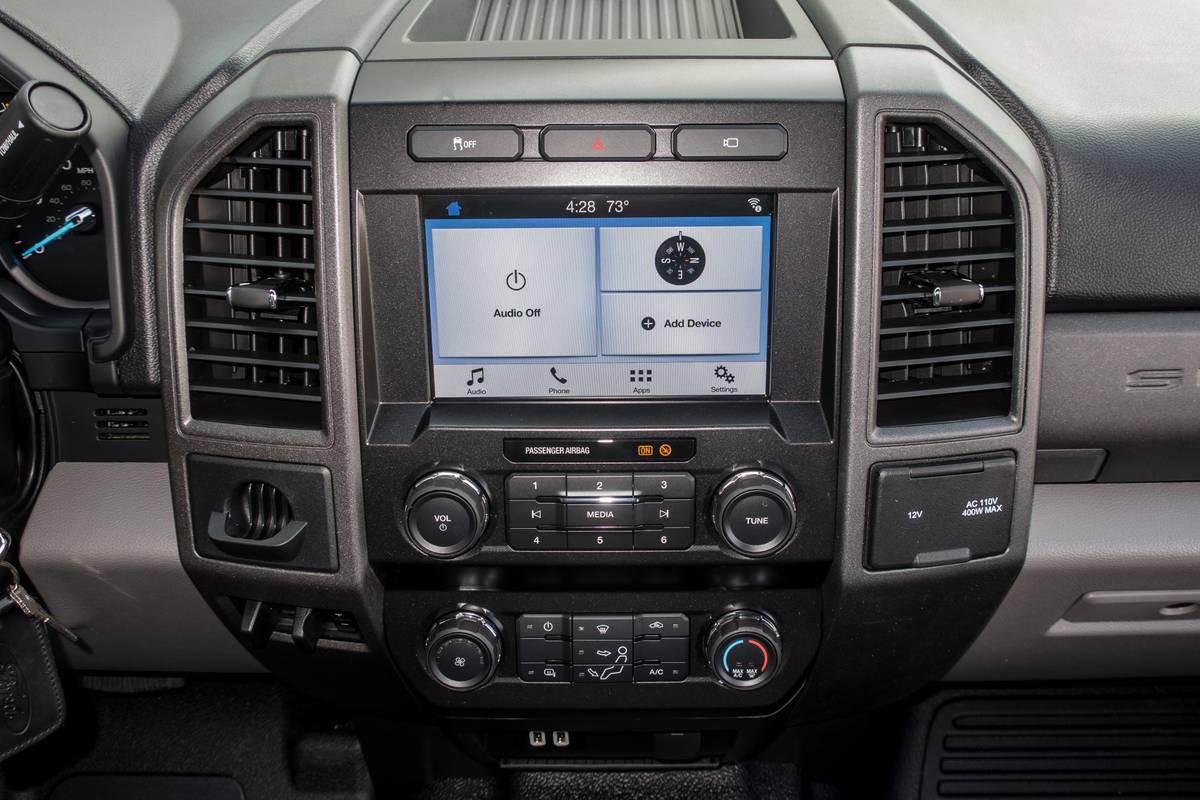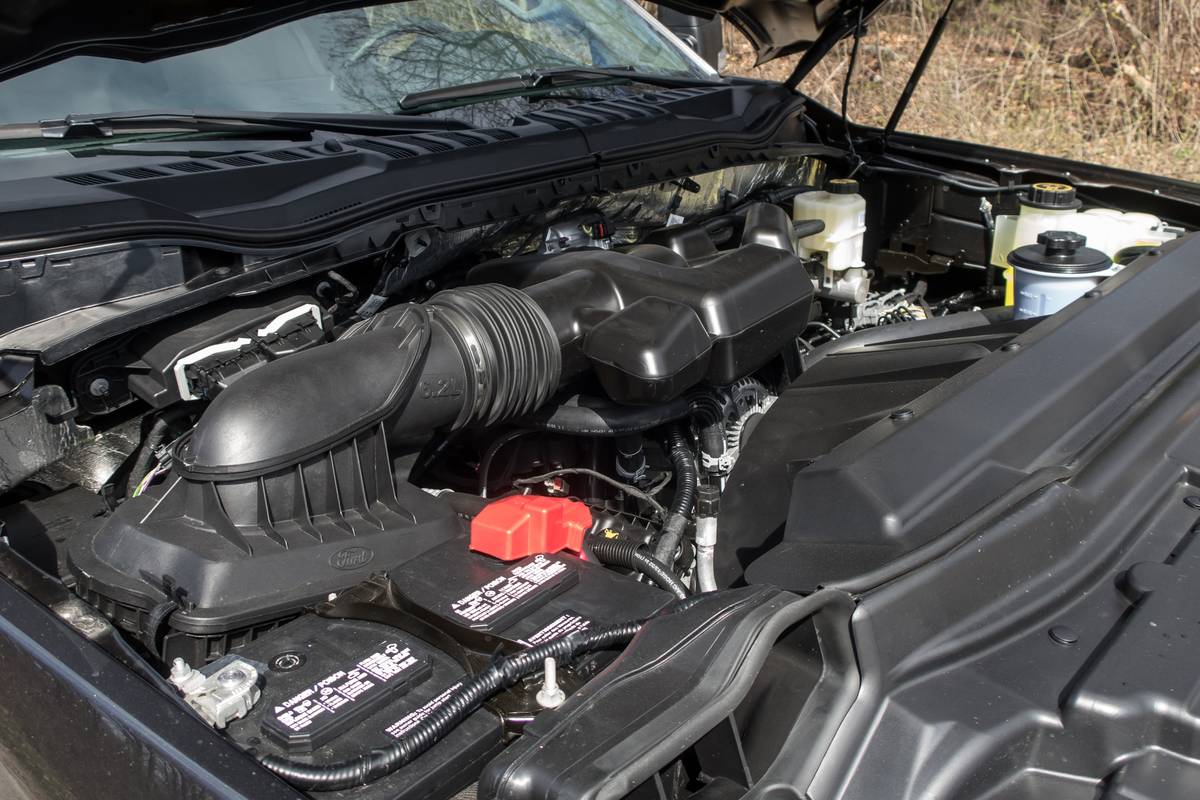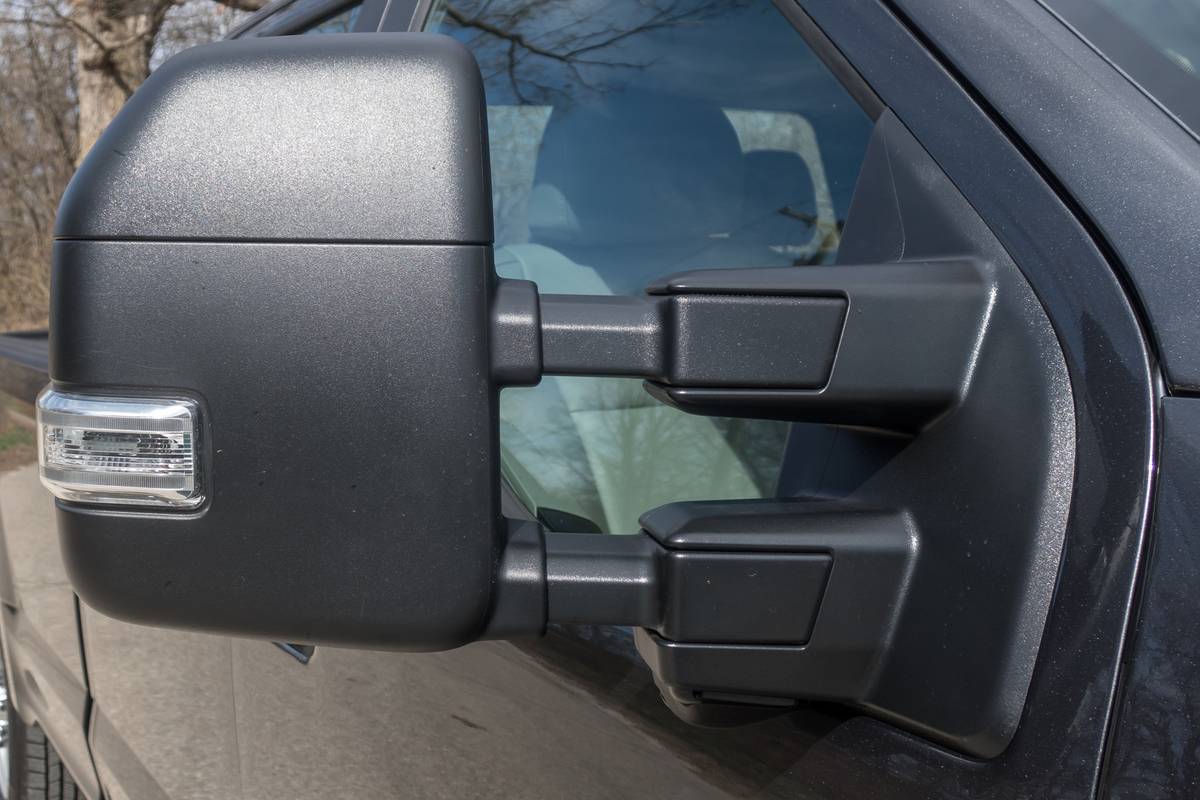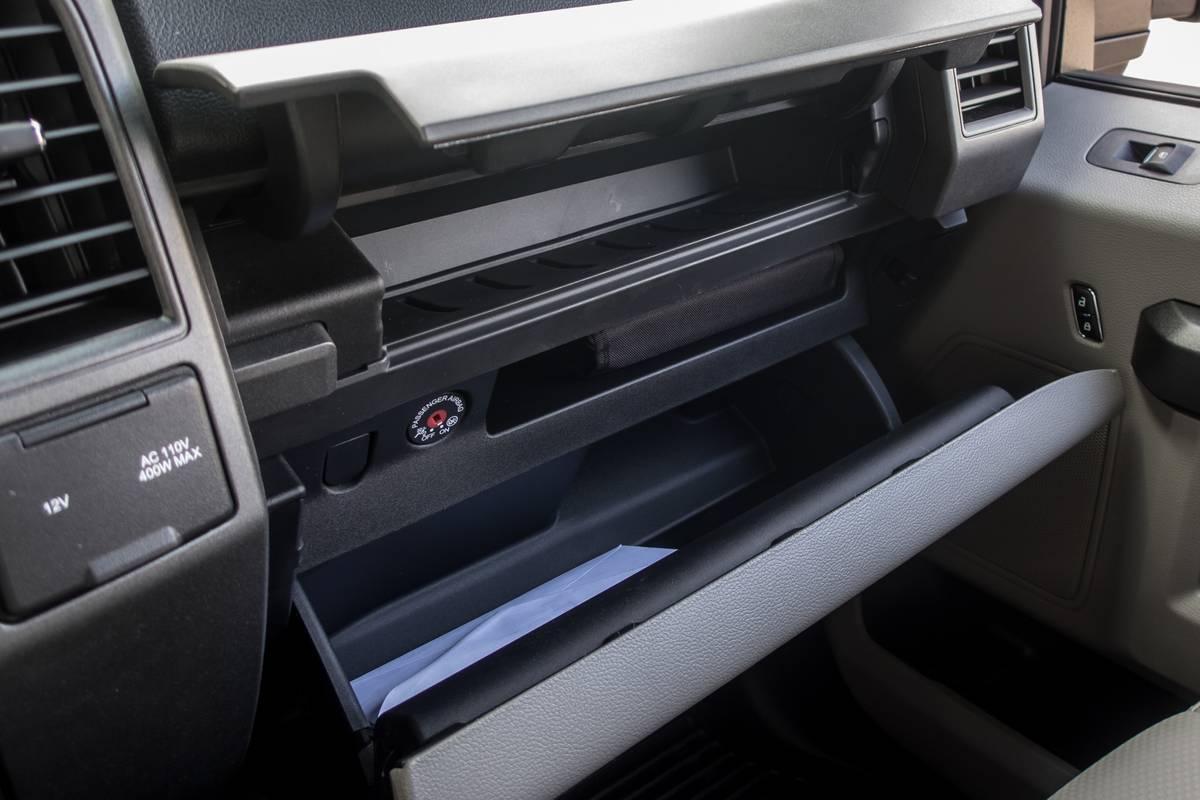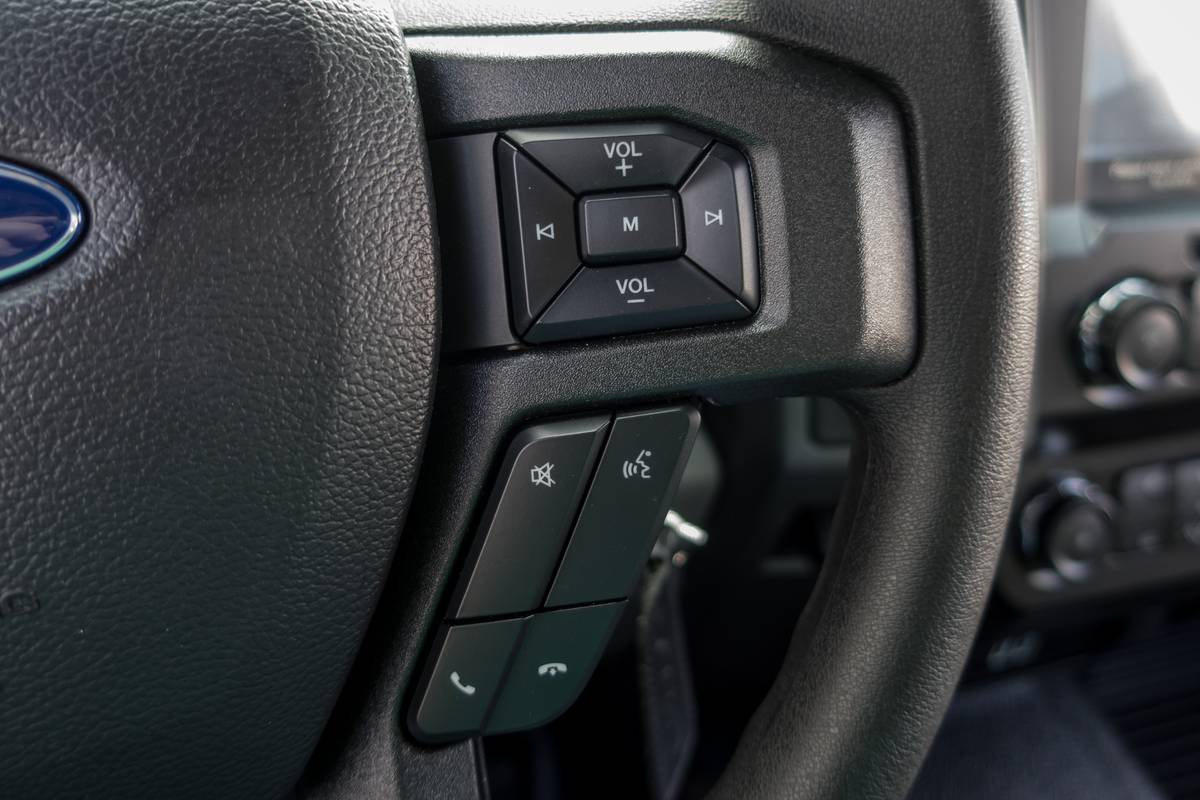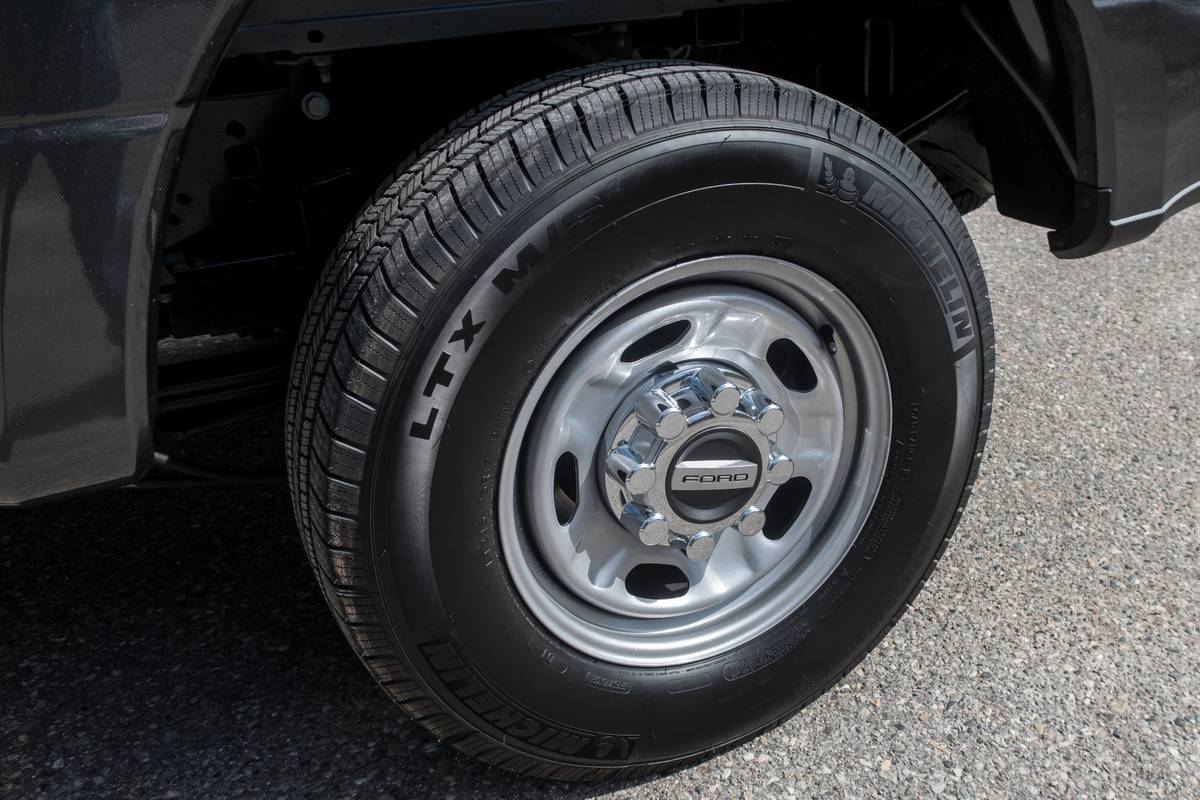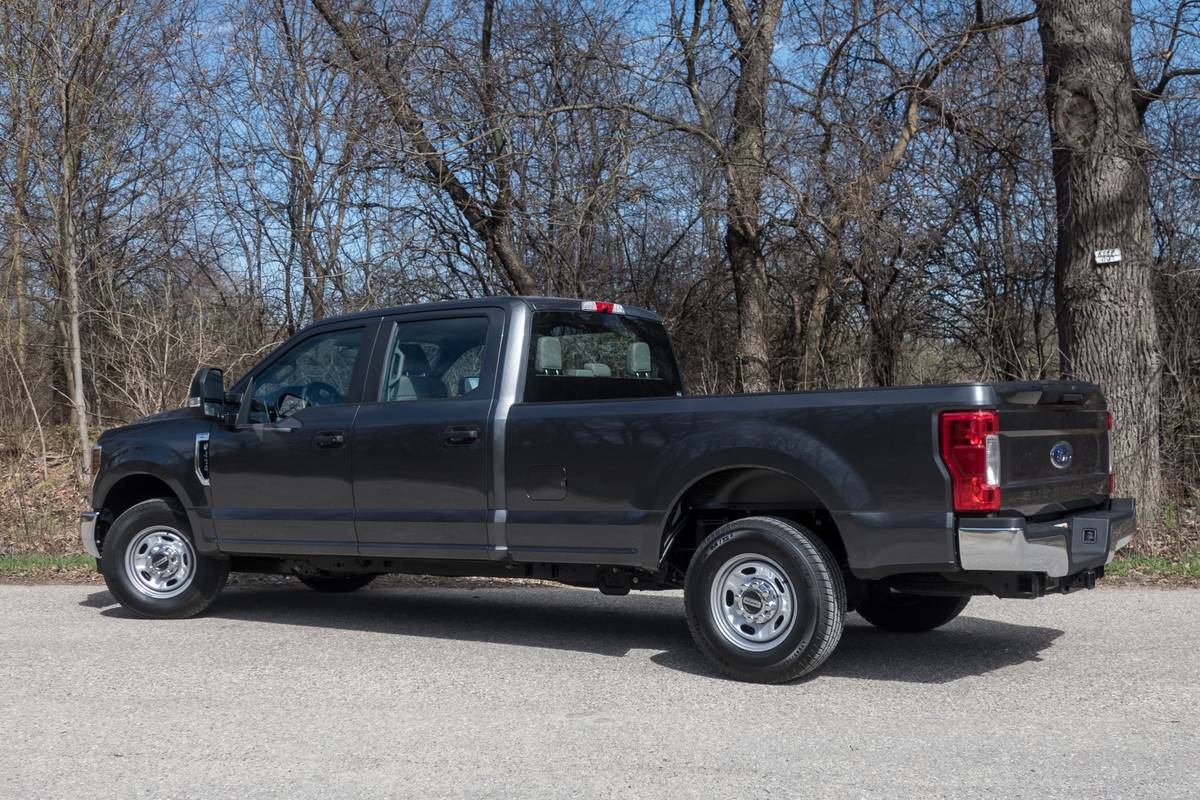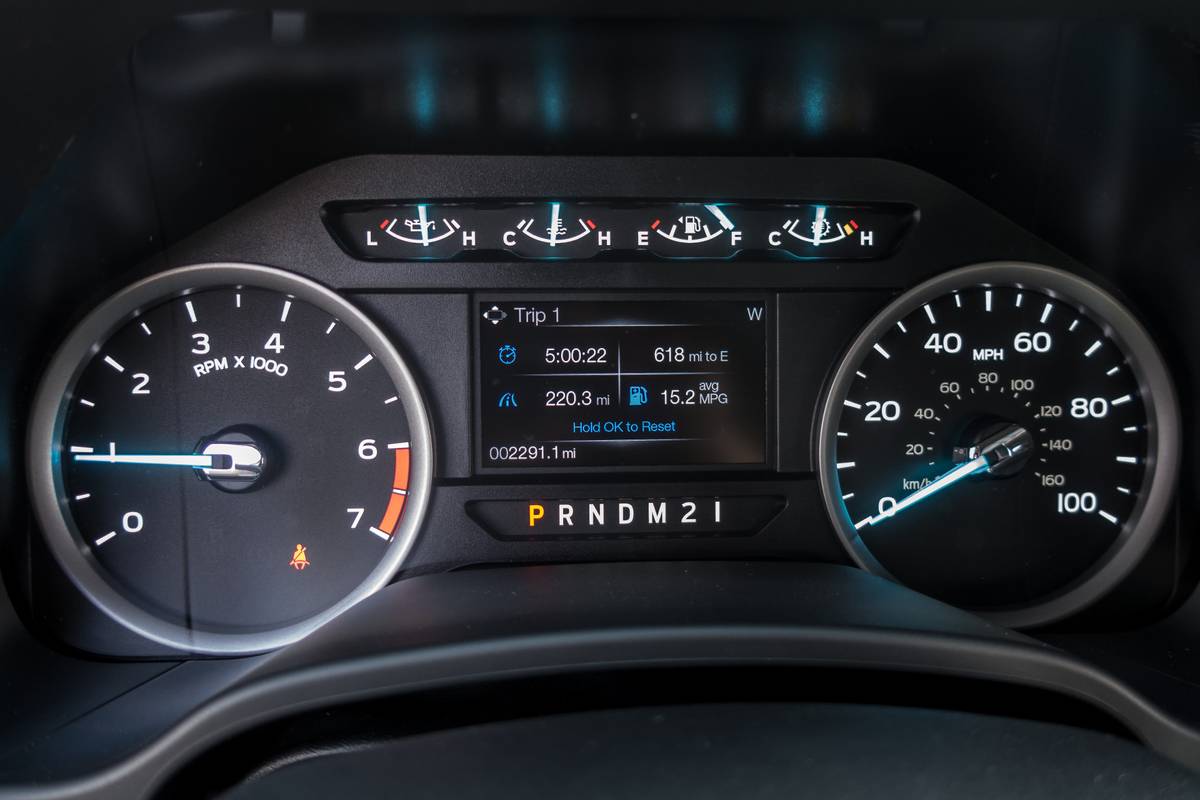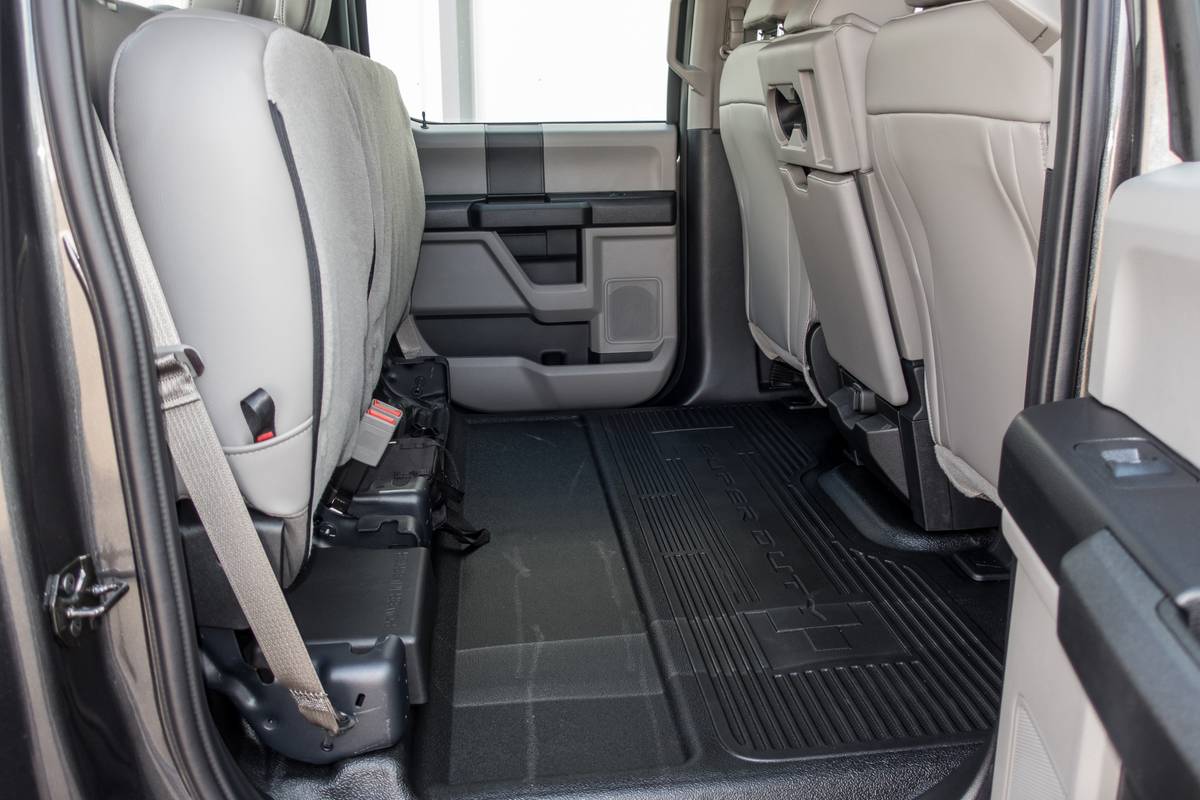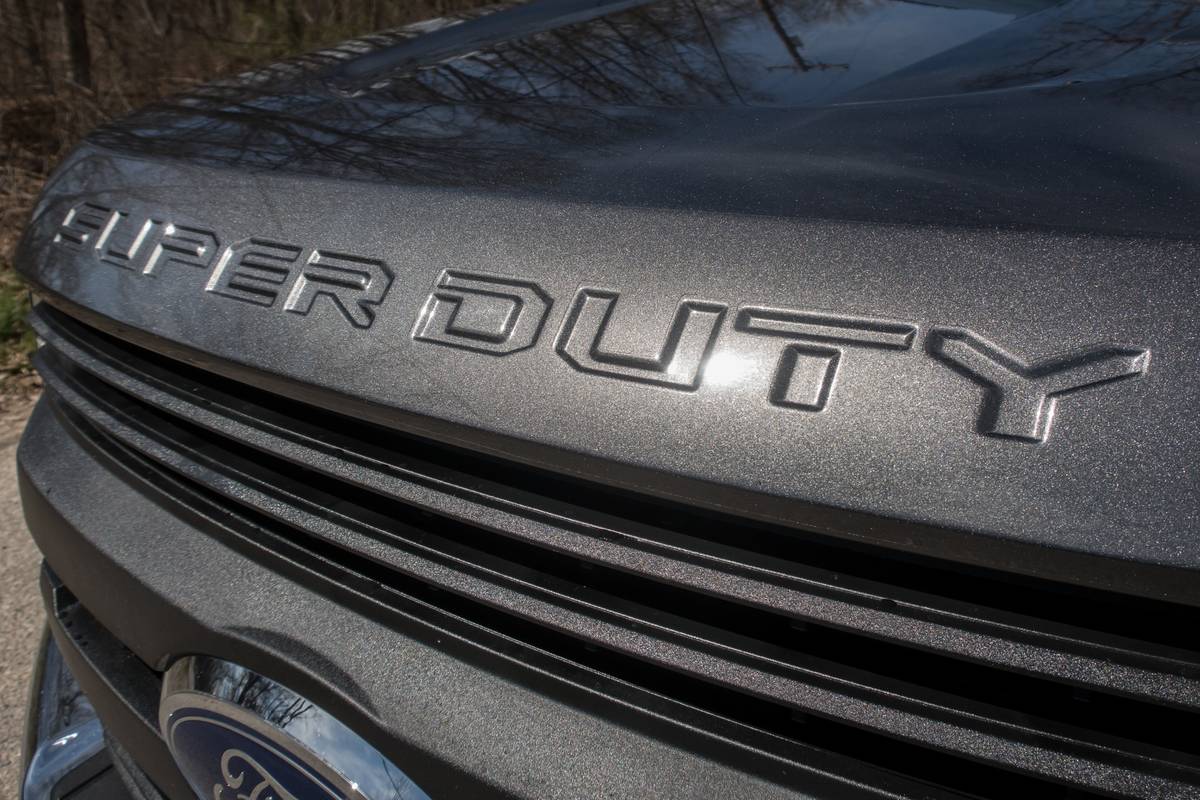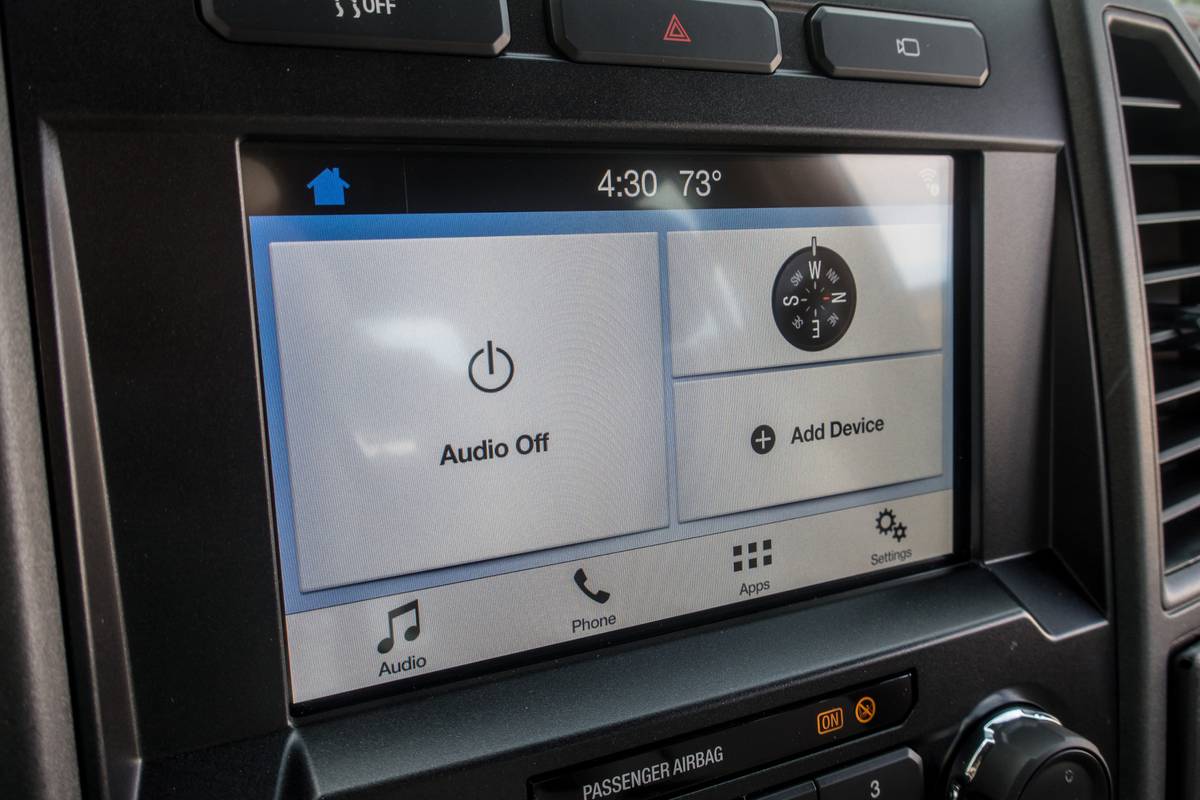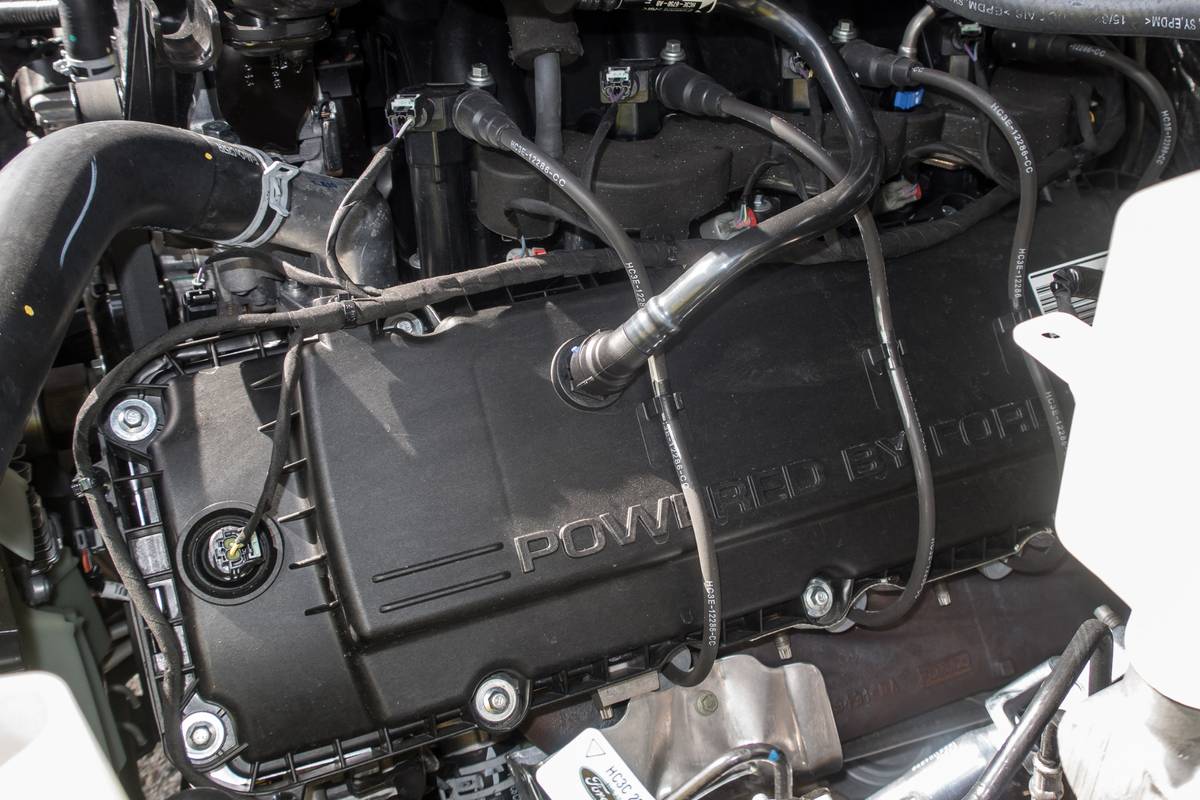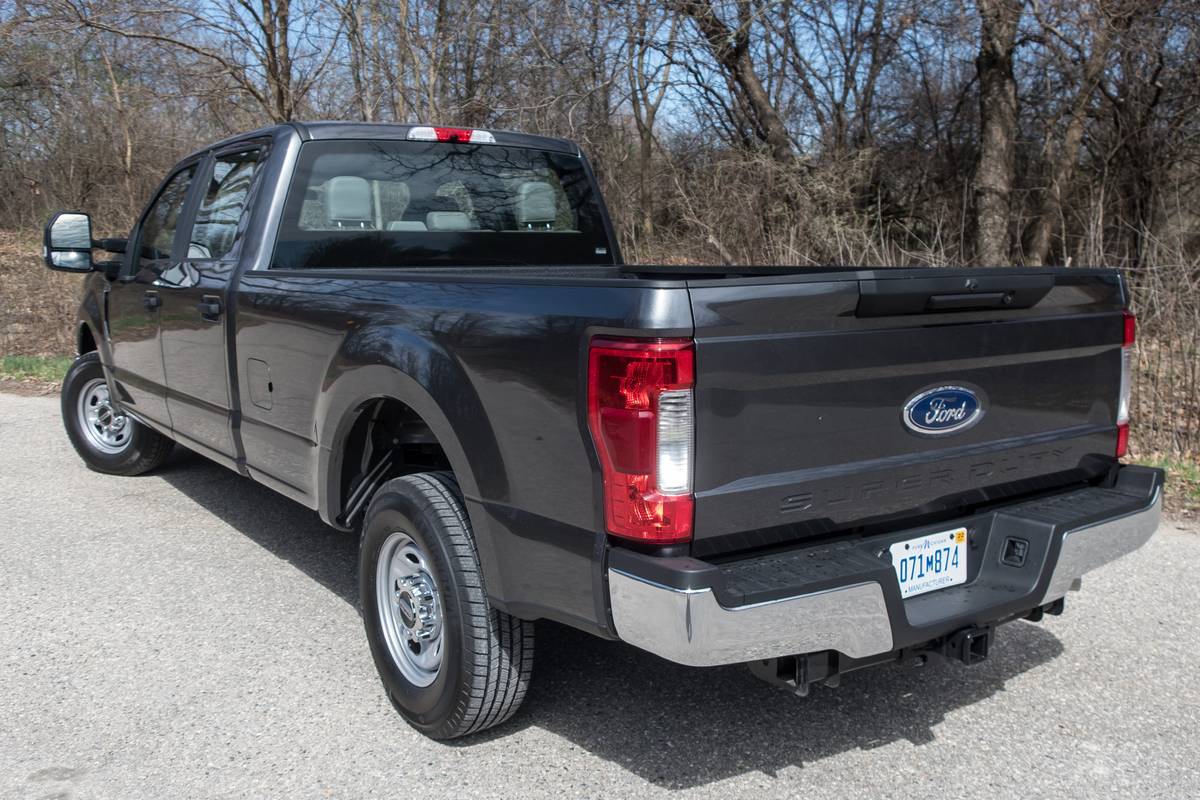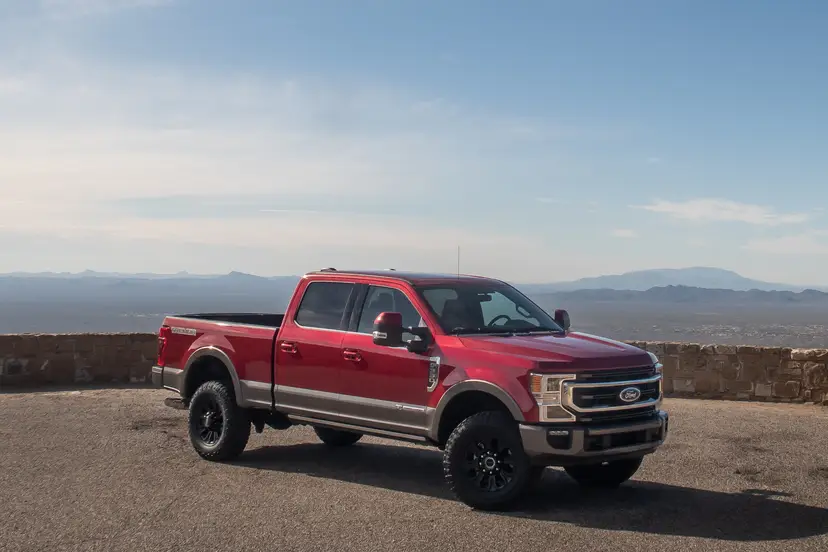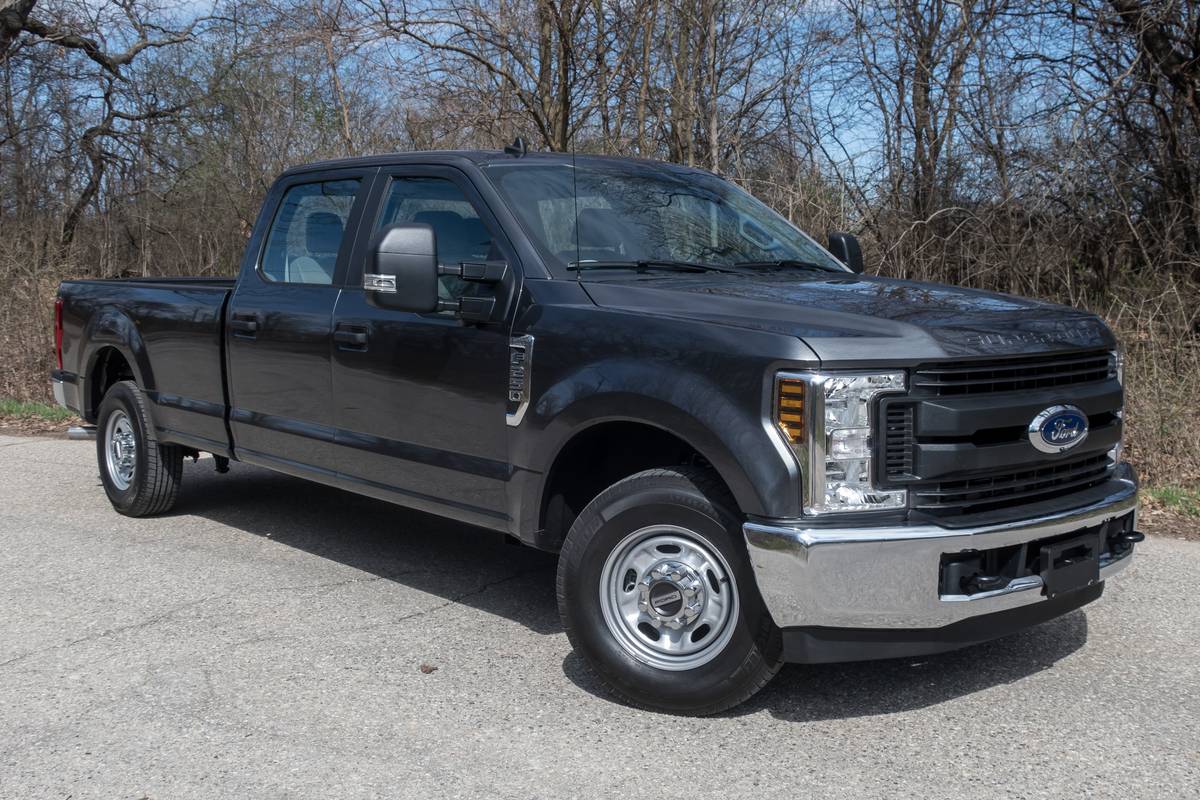
The verdict: The 2019 Ford F-250 Super Duty XL proves that you don’t need to spend crazy money to get a super capable, spacious, relatively efficient work truck.
Versus the competition: The Chevrolet Silverado 2500 and Ram 2500 both outgun the base F-250 in power, torque and towing capability, but all offer comparable technology at a comparable price; picking one is more a matter of preference and available cash incentives.
Have a look at one of the most popular vehicles in the land — the basic work pickup truck. This example is the 2019 Ford F-250 Super Duty done up in the lowliest, base XL trim level. It has vinyl seats and floors. There’s no fancy trim in here, no power retractable running boards, nothing that detracts from this truck’s mission: Get things done. Pull stuff, plow stuff, haul stuff, tow stuff.
As a result of this single-mindedness, the price tag for this example of Dearborn’s finest engineering is uncharacteristically low — it barely topped $44,000 as tested. But is a heavy-duty pickup with such a low price tag any good? Does it actually get the job done? Lacking much in the way of creature comforts and amenities, will you want to push it off a cliff before your workday is done?
So Long, So Very Long
The model I tested is not a common configuration; it was a long-wheelbase, long-bed SuperCrew four-door model with a gas engine. To call it long would be an understatement: Imagine piloting a seagoing cargo vessel around your town, and that’s not far off the mark. Parking is an adventure, corners are taken extra-wide, and there won’t be much room for anything else in your driveway. But that’s OK, as this is just one configuration out of dozens available for the Super Duty.
The XL trim doesn’t have much of the bling that other trim levels do, but it still has a goodly amount of chrome (because pickups need chrome in order to be pickups in some parts of the country). Bumpers front and rear are shiny, but the massive shieldlike grille is black plastic. There are no fancy LED headlights here, just standard halogen lamps up front and in back. No fancy wheels, either: You’ve got standard 17-inch steelies all around shod with Michelin LTX M/S2 tires, which are a surprisingly high-end brand for such a basic work truck and likely a strong reason why this Super Duty is so quiet at speed.
Adequately Powered, Outgunned by Competitors
Powering this version of the Super Duty is a standard 6.2-liter V-8 engine mated to a six-speed automatic transmission. There’s also an optional Power Stroke turbo-diesel, but it’s significantly more expensive. The base engine cranks out a healthy 385 horsepower and 430 pounds-feet of torque, significant numbers for a naturally aspirated engine, but it’s outgunned by the competition: By comparison, the Ram 2500 Tradesman’s base engine is a 6.4-liter Hemi V-8 making 410 hp and 429 pounds-feet of torque mated to an eight-speed automatic, beating the Ford in horsepower and roughly matching it in torque. And the upcoming 2020 Chevrolet Silverado 2500’s base engine is a 6.6-liter V-8 making 401 hp and 464 pounds-feet of torque. For 2020, the Super Duty will get some new powertrains, but the base engine and transmission combination carries over unchanged, so opinions here will also likely apply to the new, refreshed model’s powertrain, as well. A 7.3-liter V-8 will join the lineup, but as Ford hasn’t published any output data yet, we can’t tell you if it will be competitive.
As good as Ford’s turbocharged V-6 engines are in the lesser half-ton models, there’s really no beating the V-8 in this three-quarter-ton truck. Smooth and quiet, the power it produces is always just a quick, light stab of the accelerator pedal away. It’s accompanied by a signature rumble that just seems to fit perfectly with a big pickup like this. Sure, you can opt for the big turbo-diesel 6.7-liter Power Stroke, but now you’re looking at adding a huge chunk of change to the bottom line — $9,120 to be precise, and that will defeat the idea of this being a reasonably priced work truck. For towing, the diesel is hard to beat, but the gas engine is no slouch, either: The payload rating on this specific version of the F-250 Super Duty is 3,660 pounds, and the max tow rating is 12,900 pounds from either the bumper or the fifth-wheel/gooseneck position. It should be noted that a comparable new 2020 Chevrolet Silverado 2500 is rated to tow a 14,500-pound trailer, and a similar Ram 2500 can manage 14,580 pounds, both with a 3.73 axle. If my F-250 Super Duty had the more aggressive 4.10 rear axle, its capacity would be boosted to 15,400 pounds, but this rig was equipped with the more fuel-friendly 3.73.
The ride in a pickup like this is always going to be questionable when there’s no load in the bed — heavy-duty springs and shocks meant to carry thousands of pounds of cargo have to be robust, and that usually translates into a choppy, bouncy ride. The Super Duty does exhibit this behavior, but not nearly as much as I’ve experienced in other heavy-duty pickups. Credit the long wheelbase for smoothing out a lot of the undulations and road imperfections that would normally set your teeth chattering over broken pavement; in this example of the Super Duty, it’s a bit rough, but it’s not unpleasant or unbearable.
Most surprising is how well the big truck handles. Despite its obvious size and bulk, the Super Duty is as nimble as it can be, with steering that’s slow but direct and responsive. The truck doesn’t wallow in its lane, doesn’t wander on the highway, doesn’t feel ponderous or lazy in its body control. Ford engineers have done an excellent job making the Super Duty feel confident, solid and planted around town and on the interstate.
The 3.73 axle and high-quality Michelin tires contribute to fuel economy that’s better than expected. We performed a 200-mile loop to see how much this monster drinks, and we were pleasantly surprised at the results. Automakers aren’t required to report fuel economy numbers on vehicles with a gross vehicle weight rating more than 8,500 pounds, and the Super Duty qualifies for that exemption (originally meant for commercial trucks and not personal-use pickups). We observed 14.6 mpg in city stop-and-go traffic, climbing to an average of 15.5 mpg on the highway. Overall, the observed consumption calculated out to 15.7 mpg, which when combined with the massive fuel tank in this long-wheelbase, long-bed Super Duty, would’ve given it an unloaded range of around 750 miles.
A Useful Interior: Frugal, Not Fancy
The defining characteristic of this specific Super Duty is the frugality of the thing, and that shines through in the cabin. It’s bare-bones in here, with vinyl seats and vinyl floors, a complete absence of wood trim either fake or real, no soft-touch padding and even a vestigial bench seat up front to allow for a theoretical sixth occupant. But that’s perfectly fine, honestly — it’s refreshing to get a truck that has a purity of purpose, a work truck that looks and feels as if it’s actually meant for work, not for being a substitute for a luxury car.
The F-Series cabins are all quite spacious, and the F-250 SuperCrew with its full four doors is cavernous. There’s room for five people to stretch out, six if you want to illegally squeeze four people onto the back bench. You can try and put that sixth person in the center position on the front bench seat, where there’s a dedicated seat belt, but where they’re supposed to put their legs is a mystery. The transmission tunnel takes up any room there, and their knees would be hard up against the center console. Despite the sixth seat belt, it really is still just a five-occupant pickup regardless of its size.
From the driver’s seat, your options are a bit limited in this model. There’s no height adjustability for the driver’s seat and no telescoping steering wheel. Seats are manually adjusted and frankly aren’t very comfortable. We’ve had this complaint with Ford’s pickup seats for some time — the seat bottoms feel unnaturally short, while the lumbar support feels overly aggressive, making you feel like you’re sitting on the edge of a small seat despite the voluminous space in the cabin. They’re not terribly supportive either — after 200 miles of fuel economy testing, my back ached and my butt was numb. The backseats are more comfortable, and they fold up to reveal a flat load floor, useful for loading big items that you don’t want to expose to the elements and potential theft by hauling them in the open bed.
The list of amenities is short but mostly complete. My test truck was meant to be a towing rig and added some useful electronics such as the Ultimate Trailer Tow Camera system, which brings a 360-degree camera view to the optional big Sync 3 multimedia display. It’s invaluable for driving this behemoth through anything other than wide-open country — it makes parking in a suburban strip mall lot a little less stressful (but not a lot less), and hooking up a trailer would be a breeze thanks to the aids it provides. The blind spot warning system was also present on my test truck as an option to help on the highway, as it’s rather difficult to see small vehicles beside you given the bulk and height of the Super Duty. The XL Value Package brings cruise control and an AM/FM stereo while the Power Equipment Group added power windows and locks, a must-have in a vehicle this big lest you find yourself constantly leaning over the wide seats to unlock the door for a passenger or to crank their window closed. What doesn’t it have that it should? A rear-window defroster and a few more 110-volt outlets are about all this truck lacks to be the perfect work truck.
The F-250 gets a five-star overall safety rating from the National Highway Traffic Safety Administration, but the Insurance Institute for Highway Safety has not yet tested the big truck. Ford Co-Pilot360 hasn’t made it to the Super Duty yet, so there’s no standard forward collision warning or automatic emergency braking (they’re not available at all with this trim level). The best you get is a backup camera and the aforementioned optional blind spot warning system.
Bargain Truck, Bargain Price
It’s refreshing to see a truck that isn’t priced into the stratosphere. The base price for this rig is $38,540 (including destination fee) for the SuperCrew 4×2 version. My test vehicle included $5,770 in options, bringing the grand total to $44,310. This makes it something of a bargain, middle-weight towing rig equipped with the gooseneck hitch, gas engine and single-rear-wheel axle. It’s able to tow more than a similar light-duty F-150 and can do so more safely, but it still falls well short of the crazy capabilities of far more expensive, stronger F-350 Super Duty trucks with diesel engines and dual-rear-wheel axles.
Given that pickups are highly competitive segments, it won’t surprise you to learn that you can build a comparable Chevy or Ram for comparable money. The Ram offers items on the Tradesman that Ford doesn’t on the Super Duty, such as forward collision warning, automatic cruise control with full stop and more. What it doesn’t offer is the full 8.4-inch Uconnect multimedia system available on the half-ton Ram, which leaves it with a smaller screen than the Ford’s full Sync 3 touchscreen (which itself isn’t all that big compared to some newer screens). As for the new Silverado 2500 HD, we’re still waiting to get a shot at it as of publication, but it also stacks up well on paper with its new capabilities, big power numbers and updated onboard tech.
It’s great to know that work trucks meant for work still exist and can be had for a reasonable sum. The 2019 Ford F-250 Super Duty meets all kinds of expectations, even at the low end of the trim spectrum. Performing as well as it does for the price makes it an excellent buy.
Cars.com’s Editorial department is your source for automotive news and reviews. In line with Cars.com’s long-standing ethics policy, editors and reviewers don’t accept gifts or free trips from automakers. The Editorial department is independent of Cars.com’s advertising, sales and sponsored content departments.






















